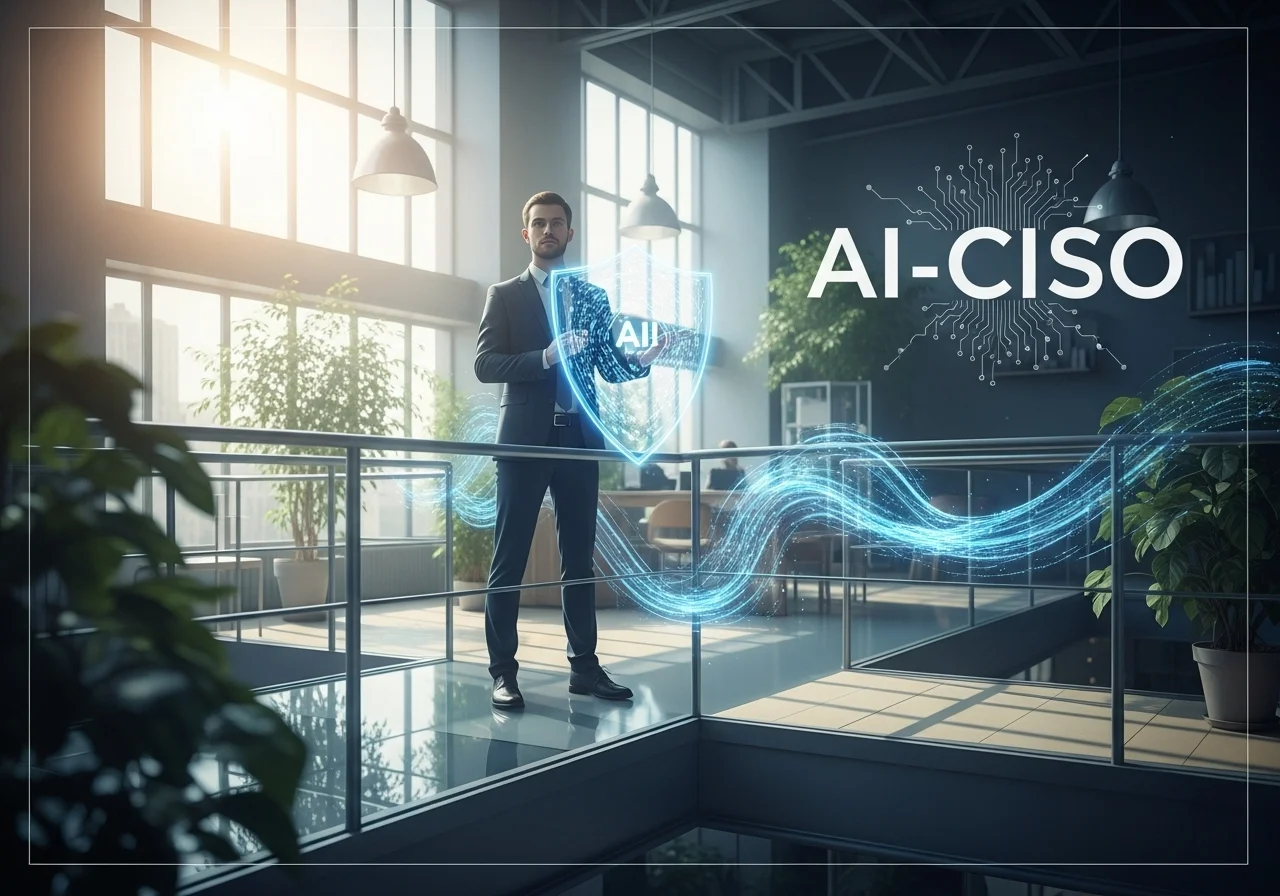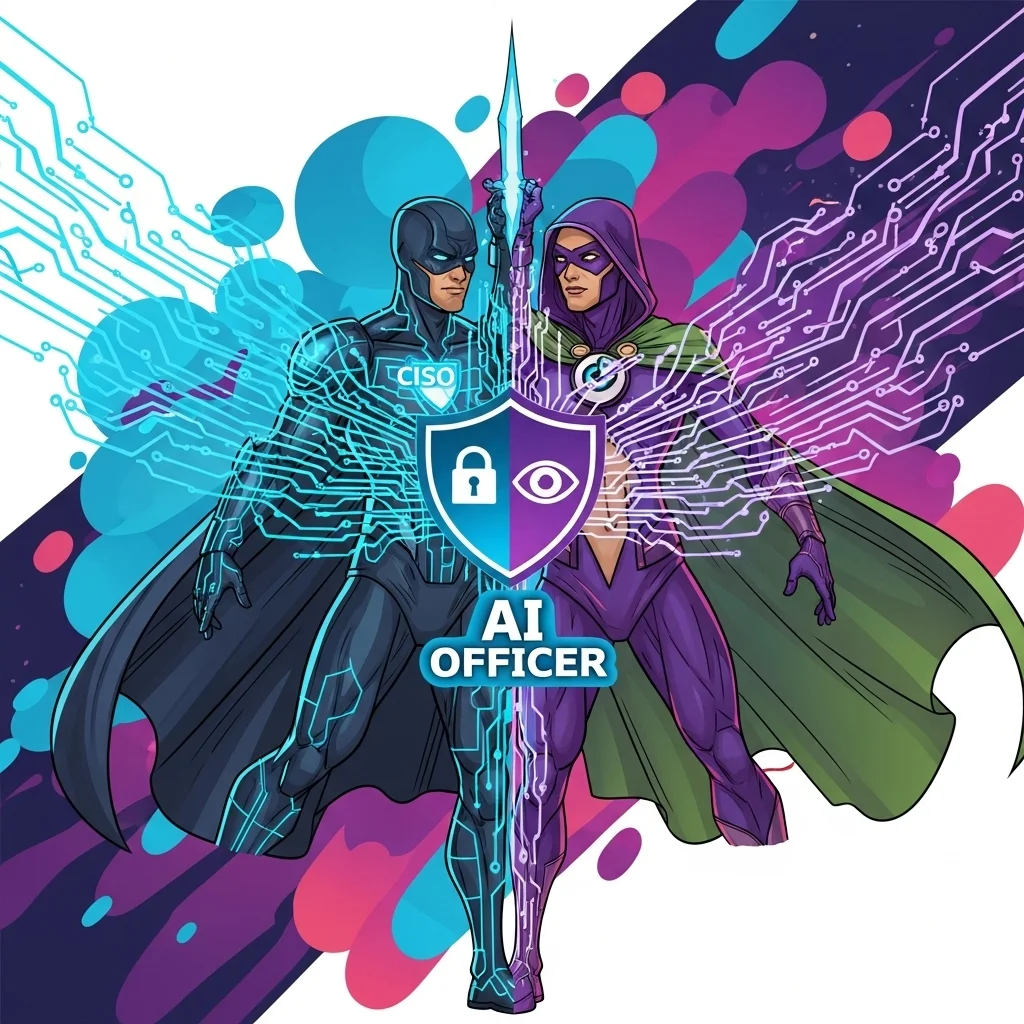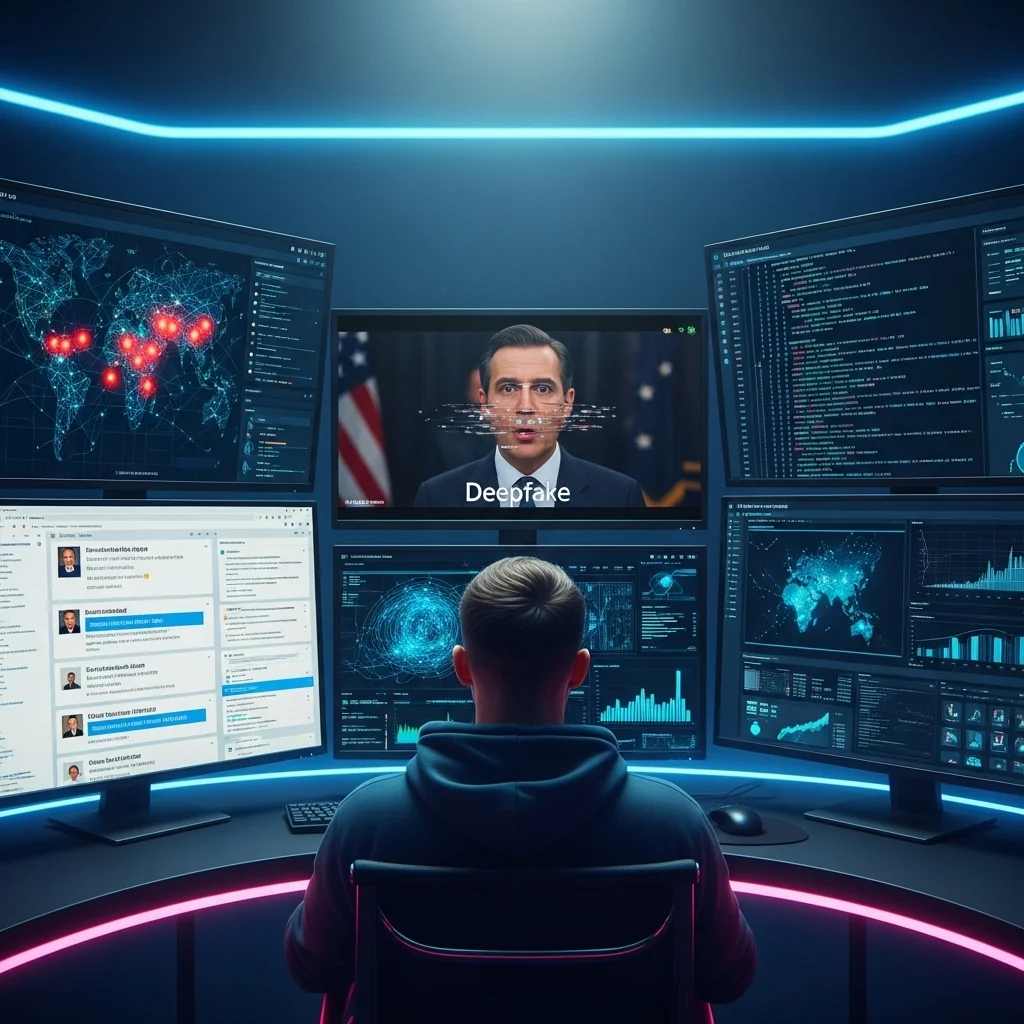AI is no longer just a tool; it is an entirely new playing field. This revolution is permanently reshaping the roles of the chief information security officer (CISO) and the privacy officer. Discover why, and how to prepare for the future of digital security and privacy. 🛡️
Is the CISO Becoming Your Organisation's New AI Officer?
AI is no longer just a tool; it is an entirely new playing field. This revolution is permanently reshaping the roles of the chief information security officer (CISO) and the privacy officer. Discover why, and how to prepare for the future of digital security and privacy. 🛡️
The Inevitable Convergence
What Does This Mean for You?
The New Skill Set for Tomorrow's CISO and Privacy Officer.
Strategic Insight
Forget the traditional firewall mentality. The AI officer proactively considers the risks of AI models, data governance and ethical implications. This is no longer a purely technical issue; it is a strategic business challenge that reaches all the way to the boardroom.
Technical Depth
You do not have to be a data scientist, but it's a black box is no longer an excuse. It is crucial to understand concepts such as adversarial attacks, data poisoning and model theft if you want to protect your organisation effectively against the next generation of threats.
Ethical Compass
AI systems make decisions with enormous impact. As AI officer, you are the organisation's ethical compass. You guide colleagues through the grey areas of bias, fairness and transparency, and you build a culture of responsible AI.
The New Battlefield: AI as Weapon and Shield
How Artificial Intelligence Is Rewriting the Rules of Cybersecurity.
Have you ever wondered what happens when the world's smartest technology falls into the wrong hands? This is no longer science fiction—it is today's reality. We are witnessing a fascinating yet frightening arms race. On one side, cyber-criminals use generative AI tools such as WormGPT and FraudGPT to create hyper-realistic phishing emails and deep-fake videos in the blink of an eye. The era of spelling mistakes and clumsy sentences is over; today's attacks are personal, convincing and almost indistinguishable from the real thing.
I recently came across a case where a CEO's voice was cloned using AI to approve a fraudulent payment. It was so convincing that even close colleagues hesitated. This kind of social engineering on steroids is becoming the norm. Attackers analyse public information with AI to perfect strikes that target a single person or organisation.
The interesting part is that we, the defenders, can deploy the very same technology as our most powerful shield. It is a double-edged sword. At Spartner we see AI not as a threat but as an indispensable ally. Think about the massive amount of data a security team has to analyse every day—an impossible task for humans. AI-driven systems can spot patterns and anomalies at speeds and precision previously unimaginable. They help us separate signal from noise, prioritise threats and respond to incidents far faster.
From Data Analysis to Proactive Defence
AI's role in defence goes beyond quick analysis. We use it to:
Detect anomalies: AI models learn what 'normal' network traffic looks like and raise the alarm at the slightest deviation that might signal an attack.
Predict vulnerabilities: By analysing code and systems, AI can identify potential weak spots before malicious actors discover them.
Automate responses: During an attack, AI can instantly trigger actions such as isolating an infected system, limiting the damage.
This dynamic creates an entirely new playing field. Being reactive is no longer enough. Today's CISO and privacy officer must understand the possibilities and dangers of AI inside out to think strategically ahead. You always need to stay one step ahead of the attacker—and that, my friends, is where the role of the AI officer comes in.
The AI-CISO Playbook
From Reactive Policies to Proactive AI Governance.
The traditional CISO was the gatekeeper, the custodian of systems and rules, while the privacy officer controlled data flows according to the law. Both roles were often reactive. But what if the 'tool' you have to guard is self-learning, unpredictable and sometimes opaque? Then you need a new playbook. The AI-CISO or AI Privacy Officer is not a gatekeeper but a strategic guide who helps the organisation innovate safely and responsibly.
Banning tools like ChatGPT is a short-term fix that kills innovation. Staff will use them anyway—just out of sight (shadow IT). A far better approach is to facilitate their use within clear and secure boundaries. That is where the new role begins. What is in that new playbook?
AI Risk Analysis: Beyond the Usual Suspects
Standard risk analyses no longer suffice. The AI-CISO has to understand and mitigate a new class of risks, such as:
Adversarial Attacks: subtle, malicious input designed to throw an AI model completely off course. Imagine a few pixels on an image making a self-driving car mistake a stop sign for a green light.
Data Poisoning: corrupting a model's training data. Attackers can 'train' a model to make wrong decisions or build in back doors.
Model Inversion and Membership Inference: techniques that allow attackers to deduce sensitive information—such as personal data—from model output, even when the data itself is not directly visible.
The AI Act and the GDPR: a Legal Minefield
With the arrival of the European AI Act, AI is no longer merely a technical and ethical issue; it has become a hard legal question as well. This legislation, which goes hand in hand with the GDPR, imposes strict requirements on the development, use and transparency of AI systems—especially high-risk ones. The AI officer translates this complex legal framework into practical policy. Who is liable if an AI system makes a mistake? How do you guarantee human oversight? How do you carry out a Data Protection Impact Assessment (DPIA) for a self-learning algorithm? These are the questions that keep the AI officer awake at night (so the CEO can sleep soundly 😉).
Ethical Frameworks and Bias: the Soft Side with Hard Consequences
Technology is never neutral. An AI system is a mirror of the data on which it is trained. If that data is riddled with human prejudice, the AI system will inherit and even amplify those biases, potentially leading to discriminatory outcomes in hiring processes or credit assessments. The AI officer has a crucial role here: setting ethical guidelines, facilitating discussions on fairness and transparency, and ensuring the 'human touch' remains central in technological development. This may be the hardest, yet most valuable, task of all.
I find this both fascinating and a little scary. The speed at which AI is transforming our field is unprecedented. It sometimes feels as though we are building a plane while already in the air. But one thing is crystal clear: standing still is not an option. The CISO and privacy officer who do not move with this transition will be irrelevant within a few years.
The Future Is Now
The AI-CISO is not a distant dream, but an urgent necessity for any organisation that wants to take AI seriously.
This new role bridges technology, business, law and ethics. It is the linchpin that ensures innovation does not come at the expense of security and responsibility.
Action over reaction: the focus shifts from incident resolution to proactively designing secure and ethical AI systems.
AI is dual: remember that AI is both the most powerful weapon for attackers and the strongest shield for defenders. You must understand both sides of the coin.
Technical insight is crucial: you need not be an AI developer, but you must grasp the fundamental concepts and risks so you can ask the right questions.
Humanity as a core value: ultimately, the AI officer's most important task is safeguarding the human dimension in an increasingly automated world.
How Do You Become an AI-first Security Leader?
Four Practical Steps You Can Start Taking Today.
Okay, the role is clearly changing—but where do you begin? It can feel overwhelming. From our experience at Spartner we know it is a journey, not a destination. Here are four concrete steps to kick-start that journey.
Step 1: Dive Deep into the Subject 📚
Go beyond the buzzwords. Do more than follow the news—invest time in understanding the fundamentals. Learn what a Large Language Model (LLM) really is, how machine learning works, and the difference between supervised and unsupervised learning. There are countless online courses—from Coursera to local initiatives—to help you.
Step 2: Think Like an Attacker 😈
The best defence is a good offence. Ask yourself, “If I wanted to attack my own organisation with AI, how would I do it?” Organise a brainstorming session with your team.
Could you create a deep-fake of the CFO to authorise a fake invoice?
Could AI craft the perfect spear-phishing email for a developer with source-code access?
How would you 'poison' the training data of an internal AI model?
Step 3: Build a "Responsible AI" Framework 🏗️
Do not wait for an incident. Start drafting internal guidelines for AI use right now. This need not be a 100-page tome—begin simple.
Our approach: start with a few basic principles such as: “We never use AI with sensitive customer data,” “Every AI application is assessed for bias,” and “There is always some form of human oversight.” Communicate this clearly throughout the organisation. It provides clarity and fosters a culture of responsibility.
Step 4: Collaborate with Development and Business Teams 🤝
The days of security as a secluded island are over—especially with AI. The AI-CISO must collaborate from day one with the development teams building the AI models and the business teams eager to deploy them. Integrate security and privacy checks into the development process security by design.
What we do: we run joint sessions where developers, security experts and business stakeholders discuss risks and opportunities together. This prevents security from becoming a brake on innovation and ensures you jointly build secure, valuable solutions.
Frequently Asked Questions About the AI-CISO and Privacy Officer
Your Questions, Our Real-World Answers.
What Exactly Is an AI-CISO or AI Privacy Officer?
It is less a formal job title and more an evolution of existing roles. It is a CISO or privacy officer with in-depth, strategic knowledge of AI—someone who not only enforces the rules but proactively guides the organisation in the safe and ethical implementation of artificial intelligence.
So, Is 'AI Officer' a Real Job?
Yes. We are seeing this title pop up more and more, particularly in larger organisations and the public sector. Sometimes it is called 'AI Compliance Officer' or 'Head of Responsible AI'. Whatever the label, the responsibilities are similar: overseeing AI governance, risk management and ethics.
But Isn't AI Just Another Tool? Why Is This Shift So Fundamental?
Great question! The difference is that traditional software does exactly what you programme. AI systems can learn and display unpredictable behaviour. They are often a 'black box', which makes their decisions hard to explain. That requires a completely different approach to risk, security and oversight.
What Is the Biggest AI-Related Threat to Businesses Right Now?
In our experience, it is the highly sophisticated phishing and social-engineering attacks. The ability to create personalised and persuasive fake messages—or even voices and videos—with AI makes employees the most vulnerable link. Raising awareness is crucial.
How Does the EU AI Act Affect This Role?
Enormously! The AI Act places the responsibility for safe and reliable AI largely on the organisation. The AI officer becomes pivotal in complying with this legislation: performing risk classifications, ensuring transparency and documentation, and demonstrating that all requirements are met. This makes the role essential for compliance.
Can't We Just Block Tools Like ChatGPT as a Company?
You can, but it is rarely the best strategy. It leads to 'shadow AI', where employees use the tools on private devices without any oversight. A better approach is to create a safe, controlled environment—a sandbox—where staff can experiment, and to establish clear guidelines on what type of information may or may not be used.
I'm a CISO/Privacy Officer. Where Should I Start to Expand My Knowledge?
Start small! Read blogs, follow experts on LinkedIn and enrol in an introductory course on AI and machine learning. Experiment with the technology yourself. The most important step is to change your mindset: see AI not as an IT problem but as a strategic challenge—and opportunity.
The rise of the AI-CISO is one of the most exciting—and arguably most important—developments in our field. It is a challenge, but also an incredible opportunity to add more value than ever.
How do you see this? Are you noticing the same shift in your organisation, or does it still feel like tomorrow's world? I am keen to hear your thoughts and experiences. Share them below, or let's have a chat about it! 🚀




